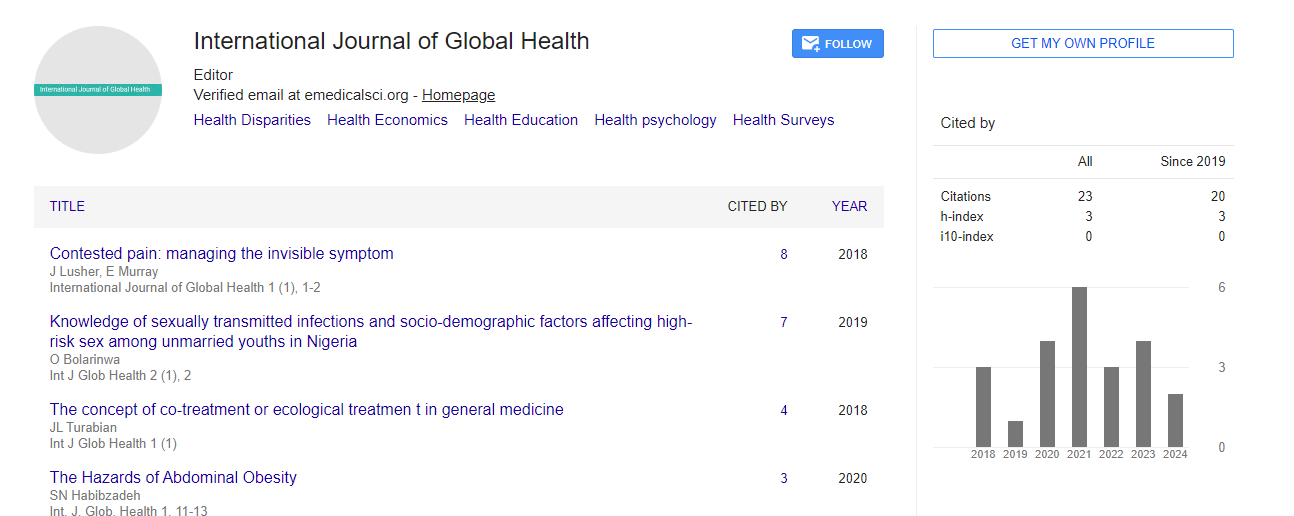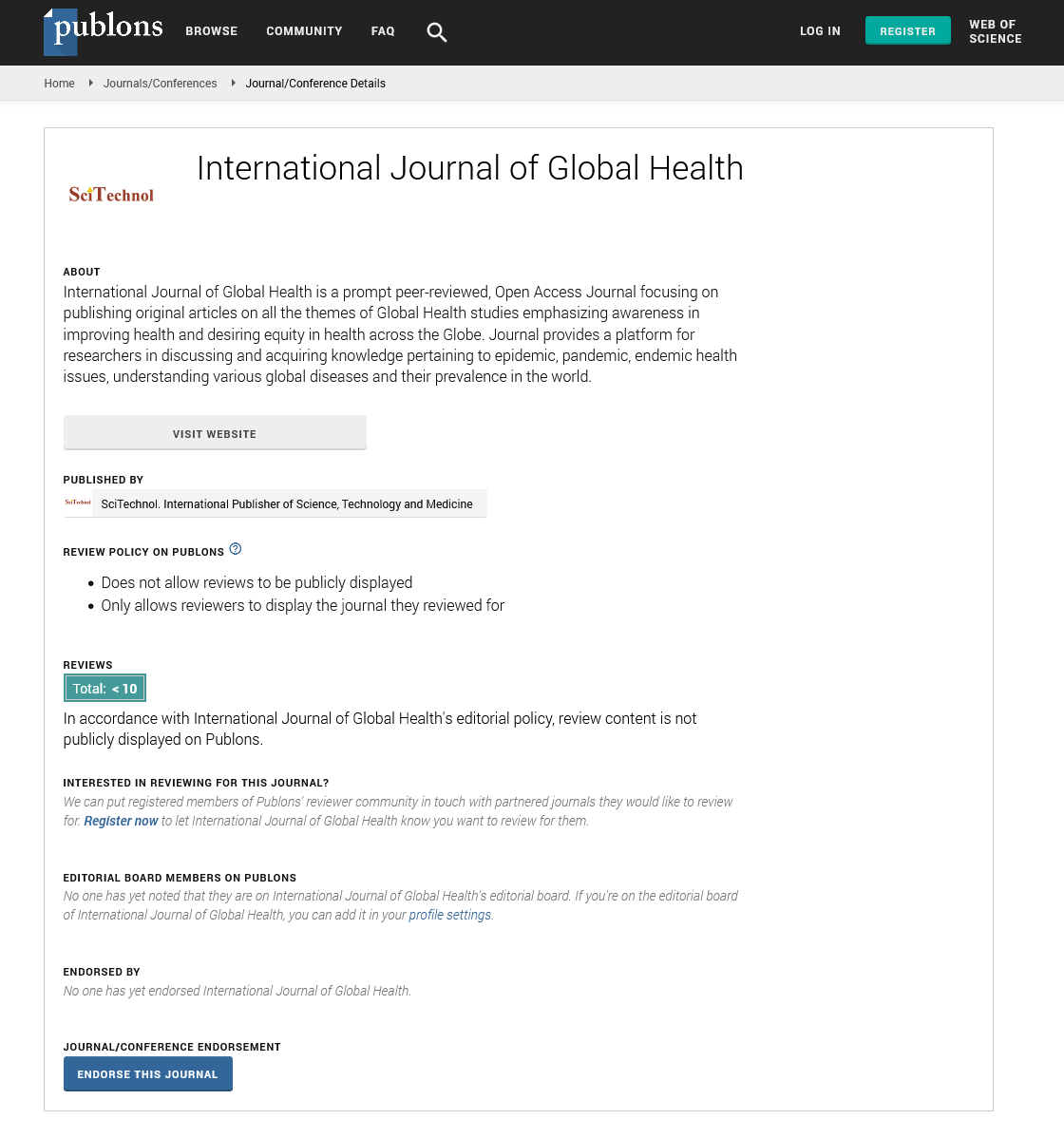Opinion Article, J Clin Image Case Rep Vol: 7 Issue: 3
Cardiovascular Disease: Bridging Awareness and Prevention through Public Health
Yun Li*
1Department of Public Health, North China University of Science and Technology, Tangshan, China
*Corresponding Author: Yun Li,
Department of Public Health, North China
University of Science and Technology, Tangshan, China
E-mail: liyun8056@163.com
Received date: 26 August, 2024, Manuscript No. IJGH-24-148984;
Editor assigned date: 28 August, 2024, PreQC No. IJGH-24-148984 (PQ);
Reviewed date: 11 September, 2024, QC No. IJGH-24-148984;
Revised date: 19 September, 2024, Manuscript No. IJGH-24-148984 (R);
Published date: 25 September, 2024, DOI: 10.4172/Ijgh.1000207.
Citation: Li Y (2024) Cardiovascular Disease: Bridging Awareness and Prevention through Public Health. Int J Glob Health 7:3.
Abstract
Description
Cardiovascular disease (CVD) remains a leading cause of morbidity and mortality globally. According to the World Health Organization, CVD accounts for approximately 32% of all deaths each year. Given its severe impact on individuals and healthcare systems, public health initiatives aimed at raising awareness and preventing cardiovascular disease are essential. This study discovers the importance of public health campaigns, strategies to enhance awareness and the role of community engagement in combating cardiovascular disease. CVD encompasses a range of conditions affecting the heart and blood vessels, including coronary artery disease, heart failure, arrhythmias and cerebrovascular disease. Risk factors such as hypertension, high cholesterol, smoking, physical inactivity, obesity and diabetes significantly contribute to the incidence of CVD. Understanding these factors is essential for developing effective public health strategies.
Public health awareness campaigns play a vital role in educating individuals about the risk factors associated with CVD. Increased knowledge can lead to early detection and management, ultimately reducing morbidity and mortality rates. Awareness initiatives can influence lifestyle choices, encouraging individuals to adopt healthier behaviors. This can include dietary changes, increased physical activity, smoking cessation and regular health screenings. Public health campaigns can empower communities to take charge of their health. By promoting a sense of responsibility, individuals are more likely to engage in preventive measures and support one another in making healthy choices. CVD disproportionately affects certain populations, including those from lower socioeconomic backgrounds and specific ethnic groups. Public health initiatives can address these disparities by targeting at-risk populations with tailored educational resources and support.
Effective strategies for raising awareness
Community-based educational programs can effectively raise awareness about CVD. These programs can include workshops, seminars and health fairs that provide information on risk factors, symptoms and preventive measures. Collaborating with local healthcare providers can enhance credibility and reach. Utilizing various media platforms-social media, television, radio and print can amplify the message about cardiovascular health. Campaigns that highlight personal stories, testimonials and expert opinions can resonate with a wider audience. Hashtags and challenges can also engage younger demographics, making heart health a trending topic. Integrating cardiovascular health education into school curricula can promote lifelong healthy habits among children and adolescents. Programs that teach nutrition, physical activity and stress management can instill the importance of heart health early on. Involving parents in these initiatives can further reinforce healthy behaviors at home. Employers can implement wellness programs that promote cardiovascular health among employees. Initiatives can include health screenings, fitness challenges, nutrition workshops and stress management seminars. A healthy workforce not only benefits individuals but also enhances productivity and reduces healthcare costs for employers. Creating support groups for individuals at risk for or living with CVD can promote a sense of community. These groups can provide education, emotional support and motivation to make healthier lifestyle choices. Engaging community leaders and organizations can further amplify these efforts, reaching a broader audience.
Role of technology
Advancements in technology provide new path for raising awareness about cardiovascular disease. Mobile health applications, wearable devices and telehealth services can facilitate education and encourage self-monitoring of health metrics. Social media platforms can serve as tools for sharing information and fostering discussions around heart health. Telehealth allows for remote consultations and health monitoring, making healthcare more accessible. Patients can receive guidance on managing risk factors and adhering to treatment plans from the comfort of their homes. This is especially beneficial for individuals with limited access to healthcare facilities. Numerous apps can help individuals track their physical activity, diet and cardiovascular health metrics. Many of these apps offer educational resources, reminders for medications and tips for managing stress, contributing to a comprehensive approach to heart health. Online forums and social media groups can provide peer support and facilitate information sharing among individuals affected by CVD.
These platforms can reduce feelings of isolation and encourage engagement in healthy behaviors. Public health initiatives must prioritize reducing health disparities in CVD. Targeting high-risk populations with culturally relevant education and resources can enhance the effectiveness of awareness campaigns. Collaboration with community organizations and healthcare providers serving these populations can ensure that messages are accessible and resonate with the intended audience. Developing educational materials that consider cultural beliefs, languages and practices is essential. Engaging community leaders and advocates can facilitate trust and encourage participation in health initiatives. Improving access to healthcare resources, such as screenings and preventive services, is essential in underserved communities. Public health campaigns should work to identify barriers to access and advocate for solutions that enable equitable healthcare for all.
Conclusion
Public health awareness is a basis of cardiovascular disease prevention and management. By implementing effective education and outreach strategies, advancing technology and addressing health disparities, we can significantly reduce the burden of CVD. Engaging communities, promoting healthy behaviors and empowering individuals to take charge of their heart health are vital steps toward a healthier future. As we continue to advance our understanding of cardiovascular disease, prioritizing awareness and education will be instrumental in saving lives and improving overall public health.
 Spanish
Spanish  Chinese
Chinese  Russian
Russian  German
German  French
French  Japanese
Japanese  Portuguese
Portuguese  Hindi
Hindi 
